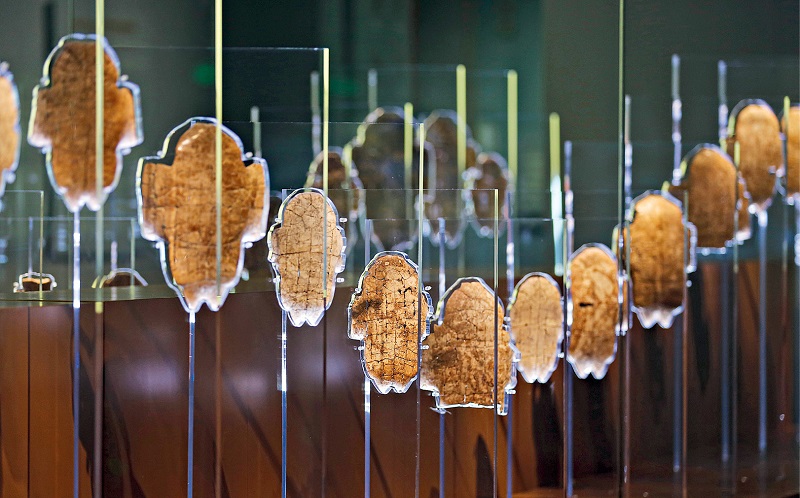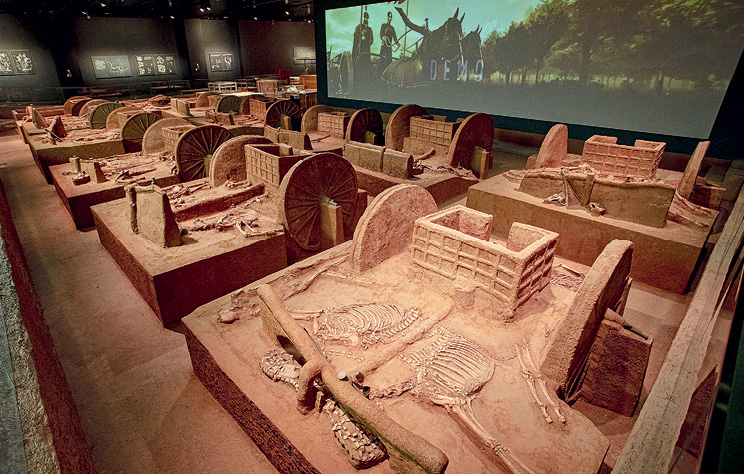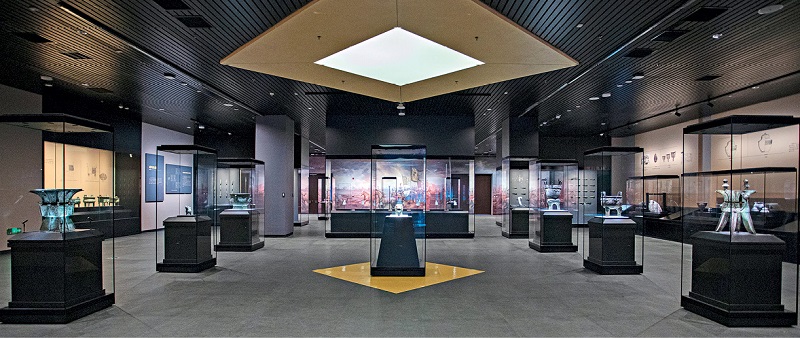
More than 110 pieces of oracle bones on display for the first time in a special exhibition tell the story of a Shang prince.
 On the banks of the An-yang River and on the Yinxu archeological site in Anyang City, central China’s Henan Province, the grand new building of the Yinxu Museum stands imposingly. This magnificent building, designed in the shape of an ancient Chinese cooking vessel with two loop handles and four legs called ding, is the first national museum offering panoramic views of the civilization of the Shang Dynasty (around 1600-1046 B.C.). The museum, boasting numerous oracle bone inscriptions, has also become one of the new cultural landmarks in China.
On the banks of the An-yang River and on the Yinxu archeological site in Anyang City, central China’s Henan Province, the grand new building of the Yinxu Museum stands imposingly. This magnificent building, designed in the shape of an ancient Chinese cooking vessel with two loop handles and four legs called ding, is the first national museum offering panoramic views of the civilization of the Shang Dynasty (around 1600-1046 B.C.). The museum, boasting numerous oracle bone inscriptions, has also become one of the new cultural landmarks in China.The exhibition hall covers an area of approximately 22,000 square meters. On display are nearly 4,000 sets of cultural relics, including bronze ware, pottery, jade and oracle bones. more than three fourths of which have never been displayed before. The exhibition focuses on the theme of the Shang civilization, showcasing China’s history and archaeological achievements, while interpreting the global significance of all the findings.
Tracing Back to the Origin
On October 28, 2022, Chinese President Xi Jinping paid an official visit to the Yinxu site. He said that it had been a dream of his to visit the site, and that this time, he came with the hope of obtaining a deeper understanding of China’s ancient civilization and drawing on inspiration for building China’s modern civilization.
Yinxu is the first capital site of the late Shang Dynasty in Chinese history confirmed by archaeological excavations and oracle bone inscriptions. With a history of more than 3,300 years, the ruins are an ideal place to explore Shang culture, its predecessor Xia culture, and the origin of the Chinese civilization.
Since the first shovel of soil dug up by the famous archaeologist Dong Zuobin in Xiaotun Village in October 1928, archaeologists have continued to conduct excavations and archeological research at the Yinxu site come rain or sunshine for nearly a century. Here, the magnificent palace complex, the large-scale royal tomb area, the exquisite bronze ware, the systematic oracle bone inscriptions, and the handicraft system with a clear division of labor all demonstrate the social and cultural aspects of the Shang Dynasty and the achievements of the Shang civilization.
With the opening of the new Yinxu Museum, Yinxu ruins, being a key site that demonstrates the origin, formation, and development of the Chinese civilization, will continue to reveal the codes of what make China what it is and carry forward the cultural roots of the Chinese nation.
“The large number and comprehensive variety of cultural relics form a rare exhibition on the Shang Dynasty,” said Gao Yong, mayor of Anyang.
“With the opening of the new museum, understanding how the ancient and modern civilization of the Chinese nation complement each other helps us carry forward the new cultural mission, and interpret the code of Chinese civilization to future generations,” Gao said.
“Cultural relics that you have seen in media reports, heard of, or even never heard of are put on display in the new museum,” said Zhao Qingrong, executive deputy curator of the Yinxu Museum. She said that the new museum has over 4,000 pieces of cultural relics on exhibit, allowing the audience to experience the infinite charm of Shang civilization in a more direct and immersive way.
Here, the Shang Dynasty recorded in Sima Qian’s The Records of the Grand Historian: The Shang Dynasty with around 3,000 ancient Chinese characters seems to have traveled through time and space to meet modern people. The continuity, succession, unity and inclusiveness of the Chinese civilization embodied in the Shang civilization are clearly visible. Also visible is the answer to the question – “What makes China a country it is?”

The Exhibition Hall of “The Racing of Carriages and the Neighing of Horses.”
Innovative Ways
“Am I seriously ill? Can I go to school?”
One day more than 3,000 years ago, Wu Ding and Fu Hao’s youngest son fell ill. He did not dare miss school for no reason. Therefore, he practiced a divination. The sentences of “Am I seriously ill? Can I go to school?” were engraved on an oracle bone, which has survived to this day.
This is just part of the content recorded in the prince’s “diary.” In the special exhibition on oracle bones, more than 110 pieces of oracle bones on display for the first time told the story of this little prince.
“This is the first time a people-themed exhibition has been planned with oracle bones that were used for divination during the Shang Dynasty as the main exhibits. It is groundbreaking,” said Yu Chenglong, curator of the exhibition and a specialist in cultural heritage and cultural relic protection and archaeological research at the Anyang Cultural Heritage Administration. According to him, his team spent over a year working to piece hundreds of oracle bones together to reveal the divination customs, clan system, social structure, and family form of the Shang Dynasty.
He Yuling, deputy director of the Anyang branch of the Institute of Archeology of the Chinese Academy of Social Sciences, participated in the entire construction of the new museum. “It is our curatorial philosophy to interpret Shang civilization in archaeologically suitable ways,” he said.
“We used scientific and technological means to reveal such basic information about Ya Chang as his gender, age, and height. We also showed his way of life, diseases, injuries, and even causes of death,” He said. In another exhibition featuring Ya Chang, a noble general during the Shang Dynasty, comprehensive and systematic excavation and research of archaeologists and the application of scientific and technological methods together presented visitors the image of a heroic figure. The exhibition hall is also installed with multimedia interactive devices. “The audio device presents the sound measurement results of three copper cymbals unearthed from Ya Chang’s tomb. The sounds from 3,000 years ago resonate with today’s audience.”
With intricate designs, the exhibition also provides the audience with a comprehensive viewing experience.
“Look, the masks here are winking their eyes, and the buffaloes are alive.” In the naked-eye three-dimensional exhibition hall, the human-faced bronze tripod from Ningxiang, Hunan Province, winks, and the kneeling jade beauty from the tomb of Fu Hao in Yinxu miraculously stands up, the animal head patterns decorating the wine vessel from Shanxi can swing the head back and forth freely, and the two-tailed bronze tiger from Da-yangzhou Township, Xingan County of Jiangxi Province, roars. Relying on digital technology, tourists can enjoy an immersive experience with more than 20 precious cultural relics from the Shang Dynasty.
In the new Yinxu Museum, digital technologies, such as artificial intelligence and multimedia, are widely used to make cultural relics, documents, and oracle bone inscriptions come alive, offering a panoramic and in-depth display of the Shang civilization with a virtual interactive experience at the tip of people’s fingers.

In the exhibition featuring Ya Chang, a noble general during the Shang Dynasty, scientific and technological methods are applied to present visitors with the image of a heroic figure.
Cultural Exchanges and Integration
The Yinxu Museum has exhibitions on Shang Dynasty by foreign galleries and museums, such as the Royal Ontario Museum of Canada and the Freer Gallery of Art in the United States, displayed in its exhibition hall.
The wonderful discussions and insights by many foreign scholars who worked hard to protect the Shang Dynasty cultural relics were also presented one after another. A large number of texts, pictures, physical objects, and interactive games vividly present for visitors the fascinating world that existed more than 3,000 years ago during the Shang period. They also demonstrate the far-reaching influence and significance of the Shang civilization on today’s world.
Aximu, a Pakistani student at Zhengzhou University, visited the museum. “The new museum is amazing, and I benefited a lot from visiting it. Through each cultural relic, I can almost see with my own eyes the life people lived more than 3,000 years ago. In particular, the bilingual introduction in Chinese and English is convenient for foreigners to have an in-depth understanding of the great Shang civilization. I believe that only through exchanges and mutual learning can we better respect and understand each other and live in harmony,” he said.
During recent years, Anyang City has organized many Chinese and foreign cultural exchange activities around the world cultural heritage of the Yinxu ruins. In 2013, a Korean tourist group visited the site, holding a special activity under the theme of “I Write Chinese Characters in the Birthplace of Oracle Bone Inscriptions.” In 2018, a coming-of-age ceremony featuring Chinese culture was held in the site, involving 3,300 students at home and abroad.
He Yuling said, “Cultural exchanges and integration are always mutual and reciprocal. They allow the Shang civilization to continue to be made known to the world and at the same time enrich itself.”